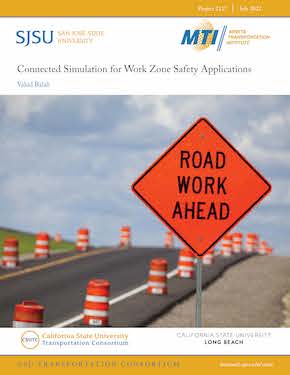- 408-924-7560
- mineta-institute@sjsu.edu
- Donate
Connected Simulation for Work Zone Safety Application
Every year, over 60,000 work zone crashes are reported in the United States (FHWA 2016). Such work zone crashes have resulted in over 4,400 fatal and 200,000 non-fatal injuries in the last 5 years (FHWA 2016, BLS 2014). Apart from the physical and emotional trauma, the annual cost of these injuries exceeds $4 million-representing significant wasted resources. To improve work zone safety, this research developed a system architecture for unveiling high-risk behavioral patterns among highway workers, equipment operators, and drivers within dynamic highway work zones. This research implemented the use of a connected virtual environment, which is an immersive hyper-realistic and virtual environment where multiple agents (e.g. workers, drivers, and equipment handlers) control independent simulators but experience an interactive and shared experience. For this project, the team conducted an in-depth analysis of accident investigation, simulated accident scenarios, and tested diverse interventions to prevent high-risk behavior. Overall, the research improved understanding of behavioral patterns that lead to injuries and fatalities of highway workers in order to better protect them in high-risk work environments. As part of making transportation smarter, this project contributes to smart behavioral safety analysis.
VAHID BALALI, PHD
Dr. Vahid Balali is the principal investigator for this research and an Assistant Professor in the Department of Civil Engineering and Construction Engineering Management at California State University Long Beach. Dr. Balali’s research focuses on visual data sensing and analytics, virtual design and construction for civil infrastructure and interoperable system integration, and smart cities in transportation for sustainable decision-making. He also has experience as a visual data analyst, and he developed a video-based construction resource tracking and action recognition tool for activity analysis of operators at Caterpillar. He has the knowledge, technical skills, and experience that are crucial to the successful completion of the proposed work.
Dr. Vahid Balali was a recipient of the 2020 Early Academic Career Excellence Award by California State University Long Beach. He was also selected as one of the Top 40 under 40 by the Consulting-Specifying-Engineer for the year 2017 and the top young professional in California by the Engineering News Record for the year 2016. He received the 2014 second-best poster award from the Construction Research Congress, as well as the 2013 CMAA national capital chapter scholarship award. He is currently an associate member of ASCE and CMAA, a committee member of the ASCE Data Sensing and Analysis and ASCE Visual Information Modeling and Simulation committees, and a friend member of relevant TRB committees. He is also serving as a reviewer of several top-notch journals. He is actively collaborating with industrial partners and is involved in professional and outreach activities.
-
Contact Us
San José State University One Washington Square, San Jose, CA 95192 Phone: 408-924-7560 Email: mineta-institute@sjsu.edu






